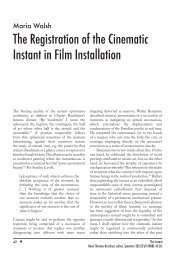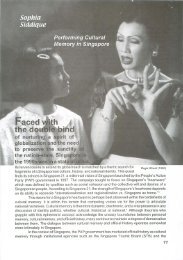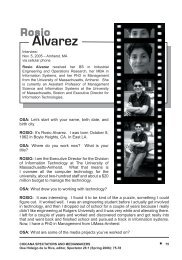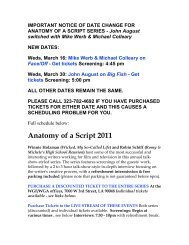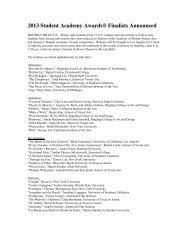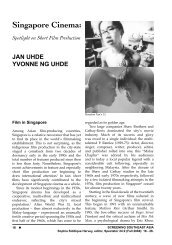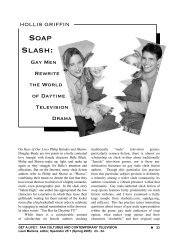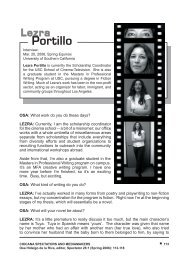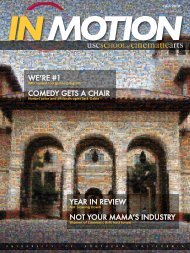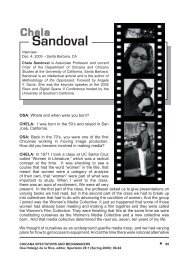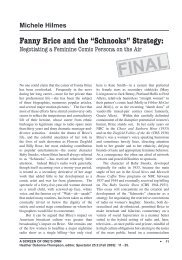The Instant Replay - USC School of Cinematic Arts - University of ...
The Instant Replay - USC School of Cinematic Arts - University of ...
The Instant Replay - USC School of Cinematic Arts - University of ...
You also want an ePaper? Increase the reach of your titles
YUMPU automatically turns print PDFs into web optimized ePapers that Google loves.
THE insTanT<br />
hAnSon<br />
assisted in the development <strong>of</strong> the journal Vectors (www.vectorsjournal.net) and is involved in ongoing<br />
game design research for the <strong>USC</strong> Game Innovation Lab and the Institute for Creative Technologies.<br />
He has worked for several years in video game design, s<strong>of</strong>tware development, and public television. He<br />
currently teaches courses in television studies at the Film and Television <strong>School</strong> at Loyola Marymount<br />
<strong>University</strong> in Los Angeles.<br />
notes<br />
1 It should be noted that an instant replay is known as an “action replay” in some countries, including the United �ingdom. �ingdom. While<br />
each term clearly carries different connotations, they should be considered interchangeable for the purposes <strong>of</strong> this article.<br />
2 Erik Barnou, Tube <strong>of</strong> Plenty: <strong>The</strong> Evolution <strong>of</strong> American Television, 2nd ed. (New York: Oxford <strong>University</strong> Press, 1990), 347-8.<br />
3 Peter B. Orlik, Hockey Night in Canada ([cited October 13 2007]); available from http://www.museum.tv/archives/etv/H/htmlH/<br />
hockeynight/hockeynight.htm.<br />
4 Other early instant replay systems such as the Ampex HS-100 employed a disk-based system similar to a phonograph to record<br />
up to 30 seconds <strong>of</strong> footage.<br />
5 Brad Schultz, Sports Broadcasting (Woburn: Focal Press/Butterworth-Heinemann, 2002), 11.<br />
6 Pr<strong>of</strong>essional tennis <strong>of</strong>fers another more recent example <strong>of</strong> incorporating replays into <strong>of</strong>ficial rules, adding adding the ability for players<br />
to challenge on-court rulings in 2006. <strong>The</strong> instant replays used in tennis are not video-based, however. Instead they are threedimensional<br />
recreations <strong>of</strong> the ball’s movement recorded by sensors and rendered as a computer simulation.<br />
7 For more on the video screens used in stadiums, see Greg Siegel, “Double Vision: Large-Screen Video Display and Live Sports<br />
Spectacle,” Television and New Media 3, no. 1 (2002).<br />
8 Margaret Morse, “Sport on Television: <strong>Replay</strong> <strong>Replay</strong> and Display,” in Regarding Television, ed. E. Ann �aplan (Los Angeles: American<br />
Film Institute, 1983), 48.<br />
9 Garry Whannel, Fields in Vision: Television Sport and Cultural Transformation (New York: Routledge, 1992), 97.<br />
10 Barbra S. Morris, “Reading <strong>Replay</strong> In ‘Live’Television ‘Live’ Television Text,” Journal <strong>of</strong> Popular Culture 20, no. 4 (1987): 149 & 52.<br />
11 Ibid.: 154.<br />
12 Aaron Foisi Nmungwun, Video Recording Technology: Its Impact on Media and Home Entertainment (Hillsdale, NJ: L. Erlbaum<br />
Associates, 1989), 100.<br />
13 Ibid., 112.<br />
14 Ibid., 131.<br />
15 Barnou, Tube <strong>of</strong> Plenty, 347-48.<br />
16 Anne Friedberg, “<strong>The</strong> End <strong>of</strong> Cinema: Multimedia and Technological Change,” in Film <strong>The</strong>ory and Criticism: Introductory<br />
Readings, ed. Leo Braudy and Marshall Cohen (New York: Oxford Press, 2004), 915.<br />
17 Vivian Sobchack, “<strong>The</strong> Scene <strong>of</strong> the Screen: Envisioning <strong>Cinematic</strong> and Electronic ‘Presence,’” in Electronic Media and<br />
Technoculture, ed. John Thorton Caldwell (New Brunswick, New Jersey: Rutgers <strong>University</strong> Press, 2000), 137.<br />
18 Laura Mulvey, Death 24x a Second (London: Reaktion Books Ltd., 2006).<br />
19 Ibid., 28-29.<br />
20 William Urrichio provides a useful historical context for this change with tracing <strong>of</strong> the technological development <strong>of</strong> television.<br />
See William Uricchio, “Old Media as New Media: Television,” in <strong>The</strong> New Media Book, ed. Dan Harries (London: <strong>The</strong> British Film<br />
Institute, 2002).<br />
21 Ellen Seiter, “Television and the Internet,” in Electronic Media and Technoculture, ed. John Thorton Caldwell (New Brunswick,<br />
New Jersey: Rutgers <strong>University</strong> Press, 2000), 228.<br />
22 William Boddy, “New Media as Old Media: Television,” in <strong>The</strong> New Media Book, ed. Dan Harries (London: <strong>The</strong> British Film<br />
Institute, 2002), 242.<br />
23 In an interesting development, a number <strong>of</strong> television commercials have appeared that employ the DVR or its interface. In a<br />
series <strong>of</strong> “DVD Ready” Sprite advertisements, “hidden” messages appear for a frame or two, encouraging the user to pore over the<br />
commercials frame-by-frame to “win” free soda. Other ads depict an artificial DVR interface to simulate a user rewinding to watch<br />
the commercial again.<br />
24 Raymond Williams, Television: Technology and Cultural Form, 2003 ed. (New York: Routledge, 1974), 83-84.<br />
25 Ibid.<br />
26 Herbert Zettl, “<strong>The</strong> Rare Case <strong>of</strong> Television Aesthetics,” Journal <strong>of</strong> the <strong>University</strong> Film Association 30, no. 2 (1978). As quoted<br />
in Jane Feuer, “<strong>The</strong> Concept <strong>of</strong> Live Television: Ontology as Ideology,” in Regarding Television, ed. E. Ann �aplan (Los Angeles:<br />
AFI, 1983), 13.<br />
27 André Bazin, “<strong>The</strong> Ontology <strong>of</strong> the Photographic Image,” in What Is Cinema?, Vol I., ed. André Bazin (Berkeley: <strong>University</strong> <strong>of</strong><br />
California Press, 1967), 14.<br />
28 Feuer, “Live Television” 13. While Zettl may overlook this aspect <strong>of</strong> the transference <strong>of</strong> “reality,” Steve Lipkin supplies a closer<br />
reading <strong>of</strong> the applicability <strong>of</strong> Bazin’s theory to televisual images. Lipkin argues that television and video are more akin to painting<br />
than film in their televisual electronic and “automatic” mediation <strong>of</strong> the image, as compared to film’s photochemical processes. See<br />
59




